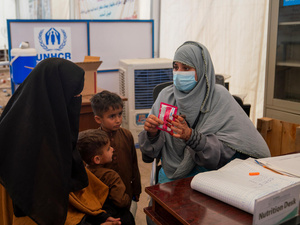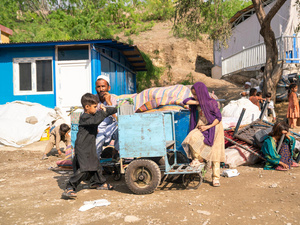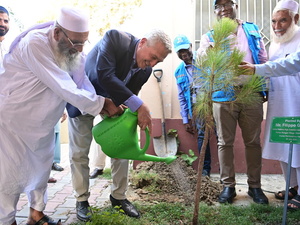Pakistan: A year on from the massive Swat exodus, the need for help remains acute
Pakistan: A year on from the massive Swat exodus, the need for help remains acute
Next week will mark for us the first anniversary of the initial stage of the emergency in northwest Pakistan's Swat Valley and surrounding districts. With more than two million people on the run this was one of the largest and fastest developing displacements that we have seen. To date, according to government estimates, 80 to 90 percent of the more than two million people who were affected have returned to their home areas. Despite this, we continue to see thousands of people still struggling to rebuild their lives.
The trigger for last year's displacement was operations by government forces against militants in Swat, Buner, and Lower Dir districts resulting in large numbers of people fleeing to the Peshawar valley. There, many were housed by the local community and in hastily established UNHCR camps. Working together with local partners, hundreds of thousands of people were registered and provided with relief items.
Today, Swat's capital Mingora is once again a bustling town, but the human cost of the conflict is still being felt there and across the Swat valley. UNHCR and its NGO partners are helping some of the most vulnerable returnees by building shelters for civilians whose homes and other property has been lost. Many families lost breadwinners and other loved ones. People remain traumatised and in need of counselling.
In Swat, Buner and Lower Dir, we are working with partners to build more than 12,000 shelters for families whose houses were badly damaged or destroyed. Typically, these people live in small rural villages and were already very poor. The programme provides families with shelters with timber frames, mud walls and corrugated iron roofs. Affected families and communities help build the shelters through a cash-for-work programme. To date, we have built 3,500 shelters across Swat, Buner and Lower Dir despite winter snows and ongoing curfews which can be disruptive.
UNHCR and its NGO partners have established 15 welfare centres in Swat and Lower Dir where psychologists continue to counsel people suffering from trauma. Community meetings are used to spread the word about the centres and the help they provide. More than 30,000 vulnerable people have been helped since November 2009. Another two centres operate in Peshawar.
The displacement crisis in north-west Pakistan is not over. In addition to those who fled last May some 1.3 million people from the Federally Administered Tribal Areas remain displaced in various parts of Khyber Pakhtunkhwa, the new name of North West Frontier Province. They fled homes in Bajaur, Mohmand, South Waziristan, Khyber, Kurram and Orakzai in various waves as security forces launched operations against militants in the tribal belt. Many of those from Bajaur have lived in camps for more than 18 months, while those from Orakzai and Kurram have fled more recently. People are still fleeing the conflict areas. In April, some 85,000 displaced people from Kurram and Orakzai were newly registered by local officials in Hangu, Kohat and Peshawar. Registration was later suspended following an attack on the registration point in Kohat on 17 April.
Today, UNHCR in Pakistan faces a complex humanitarian operation on several fronts. In addition to helping people rebuild lives and homes in return areas, new IDPs from Kurram and Orakzai need to be registered and given emergency relief. The longer-term displaced still need care. More than 130,000 people live in nine camps which have to be maintained or consolidated. New return operations to Mohmand and Bajaur are underway and these IDPs will also need help to rebuild and re-establish their lives. UNHCR is currently helping with transport for returnees and emergency shelter kits. Next month, we will start monitoring in return areas to identify ongoing needs and plan future assistance. These poor communities will need a significant investment of funds from donors to make their return sustainable.








